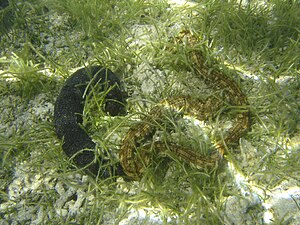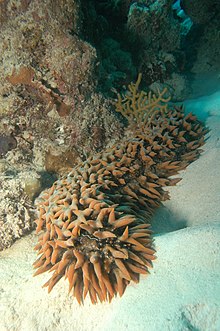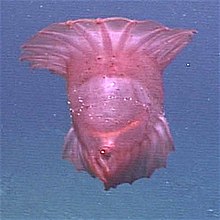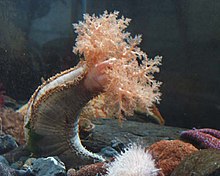Sea cucumbers
| Sea cucumbers | ||||||||||||
|---|---|---|---|---|---|---|---|---|---|---|---|---|

White-spotted sea cucumber ( Holothuria leucospilota , left) and spotted worm sea cucumber ( Synapta maculata ) |
||||||||||||
| Systematics | ||||||||||||
|
||||||||||||
| Scientific name | ||||||||||||
| Holothuroidea | ||||||||||||
| de Blainville , 1834 |

The sea cucumbers (Holothuroidea), also called sea cucumbers or holothuria , are a class in the echinoderm tribe . With good 1700 species they are, besides the brittle stars and sea stars , which form the largest group today echinoderms, including a closely related group, for example, sea urchins belong. In the deep sea , 90 percent of the near-ground biomass consists of sea cucumbers.
construction
Sea cucumbers are sea creatures with a one millimeter ( meiofauna ) to two and a half meter ( spotted worm sea cucumber ) long, cylindrical body. The five-pointed radial symmetry typical of the other echinoderms can only be recognized externally by the five rows of ambulacral feet . A secondary bilateral symmetry is often found by adapting to the soil life . The muscular, elongated body has a mouth opening at the front end, which is often surrounded by tentacles.
In contrast to other echinoderms, sea cucumbers only have skeletal trudiments in the form of small calcite needles ( sclerites ). Instead of a skeleton, they have a skin muscle tube made up of longitudinal and circular muscles and a thick layer of mutable tissue .
The blood vessel system is relatively well developed. It consists of an oral ring vessel (running around the mouth opening), from which five blind-ended radial vessels branch off. A dorsal and a ventral vessel run along the intestine and are connected to one another by pulsating connections (hearts). The water lung formed by some species is also wrapped in a network of vessels.
One can distinguish a creep sole (Trivium) from a back (Bivium). The trivium consists of three radii and two inter- radii and is characterized by a large number of ambulacral feet . The bivium, on the other hand, consists of two radii and three interradii. The feet are transformed or regressed. The movement of the sea rollers takes place by means of the ambulacral feet on the belly side .
As a further special feature, most of the foot-bearing sea cucumbers have water lungs , which are protrusions of the rectum. In the Mediterranean Sea cucumber ( Stichopus regalis ) is often found in the water lungs of the intestinal fish ( Carapus acus ), and in some cases it also lives in the water lungs of Holothuria species. In Southeast Asian Holothuria species there is regularly a transparent fish that can leave the host via the anus.
The so-called Cuvier's tubes , which can be found in a few species, on the other hand, serve to defend the animals and are sprayed in the direction of attackers in case of danger. They form sticky threads of slime that confuse the enemy and, under certain circumstances, can even render them incapable of fighting. The adhesives can also contain poisons ( holothurine ). Furthermore, it is possible for the sea cucumber to eject part of their inner bowels as a distraction to the enemy when attacked. These will be reproduced later.
food
Sediment eater and plankton eater are known to the sea rollers.
With the sediment eater (including all European species) the adult animals crawl over the bottom of the sea and in the process take up sediments with organic components such as detritus , algae and sand gap fauna . The organic components are digested and the indigestible mineral sediment is excreted. You could call these sea rollers "sea vacuum cleaners" or sediment sorters.
The plankton-eating sea rollers have a greatly enlarged tentacle ring with which they catch plankton from the water.
Reproduction
The sea rollers are separate sexes and release their sex products directly into the sea water. This usually takes place synchronously within a bay. To do this, you stand up with the front end vertically and release a whitish (sperm) to yellowish (egg) fluid at the tip. Their bilaterally symmetrical larvae live planktonically and are called auricularia . In addition to sexual reproduction, many sea cucumbers can also reproduce by dividing.
Systematics



The sea rollers are currently divided into at least eight large groups (orders) with 31 families.
- Order † Arthrochirotida Seilacher, 1961
- Family † Palaeocucumariidae Frizzell & Exline, 1966
- Order Apodida Brandt, 1835
- Family Chiridotidae Östergren, 1898
- Family Myriotrochidae Théel, 1877
- Synaptidae Burmeister family , 1837 sensu Östergren, 1898
- Order Elasipodida Théel, 1882
- Deimatidae Théel family , 1882
- Family Elpidiidae Théel, 1877
- Family Laetmogonidae Ekman, 1926
- Family Pelagothuriidae Ludwig, 1893
- Family Psychropotidae Théel, 1882
- Order Holothuriida Miller, Kerr, Paulay, Reich, Wilson, Carvajal & Rouse, 2017
- Family Holothuriidae Burmeister, 1837
- Family Mesothuriidae Smirnov, 2012
- Order Synallactida Miller, Kerr, Paulay, Reich, Wilson, Carvajal & Rouse, 2017
- Family Stichopodidae Haeckel, 1896
- Synallactidae Ludwig family , 1894
- Order Persiculida Miller, Kerr, Paulay, Reich, Wilson, Carvajal & Rouse, 2017
- Family Gephyrothuriidae Koehler & Vaney, 1905
- Family Molpadiodemidae Miller, Kerr, Paulay, Reich, Wilson, Carvajal & Rouse, 2017
- Family Pseudostichopodidae Miller, Kerr, Paulay, Reich, Wilson, Carvajal & Rouse, 2017
- Order Molpadida Haeckel, 1896
- Family Caudinidae Heding, 1931
- Family Eupyrgidae Semper, 1867
- Family Molpadiidae J. Müller, 1850
- Order Dendrochirotida Pit, 1840
- Family Cucumariidae Ludwig, 1894
- Family Cucumellidae Thandar & Arumugam, 2011
- Family Heterothyonidae Pawson, 1970
- Family † Monilipsolidae Smith & Gallemí, 1991
- Paracucumidae family Pawson & Fell, 1965
- Family Phyllophoridae Östergren, 1907
- Family Placothuriidae Pawson & Fell, 1965
- Psolidae Burmeister family , 1837
- Family Rhopalodinidae Théel, 1886
- Family Sclerodactylidae panning, 1949
- Vaneyellidae family Pawson & Fell, 1965
- Family Ypsilothuriidae Heding, 1942
Occurrence
Sea cucumbers are found in all oceans, both in shallow water and in the deep sea .
use
In Asia , pickled giblets from sea cucumbers are often prepared as a delicacy , for example the Japanese dish Konowata ( Stichopus japonicus ). In Spain , the inner muscles of the royal sea cucumber are considered a delicacy and are eaten cooked with pasta. The dried sea roll, steamed two or three times and finally smoked for several months, is called trepang (Malay for sea cucumber). It is used, for example, for the so-called trepang soup. Colorful sea cucumbers, such as the sea apples ( Pseudocolochirus ), are occasionally kept in seawater aquariums.
Names and popular things
The holothúrion (Gr.), According to Aristotle an amazing, standing between animal and plant essence. The Italian trivial name cazzo di mare , 'sea penis', is based on the visual impression when the sex products are dispensed .
swell
- ^ A b Allison K. Miller, Alexander M. Kerr, Gustav Paulay, Mike Reich, Nerida G. Wilson, Jose I. Carvajal, Greg W. Rouse: Molecular phylogeny of extant Holothuroidea (Echinodermata) . In: Molecular Phylogenetics and Evolution . tape 111 , June 2017, p. 110-131 , doi : 10.1016 / j.ympev.2017.02.014 .
- ↑ Westheide, Rieger: Special Zoology. ISBN 3-437-20515-3 , p. 827.
- ↑ Alexei V. Smirnov: System of the Class Holothuroidea . In: Paleontological Journal . tape 46 , no. 8 , December 2012, p. 793-832 , doi : 10.1134 / S0031030112080126 .
- ↑ Stichopus japonicus. Food and Agriculture Organization of the United Nations , accessed August 27, 2015 .
literature
- Hans A. Baensch , Robert A. Patzner: Mergus sea water atlas. Volumes 3, 4 + 5, Mergus-Verlag, Melle.
- Svein A. Fosså, Alf Jacob Nilsen: Coral reef aquarium. Volume 5, Birgit Schmettkamp Verlag, Bornheim, ISBN 3-86659-014-8 .
Web links
- Alexander M. Kerr: Holothuroidea , The Tree of Life Web Project
- Sea rollers in the sea water lexicon
- Video: Sea whales (Holothurioidea) . Institute for Scientific Film (IWF) 1968, made available by the Technical Information Library (TIB), doi : 10.3203 / IWF / W-954 .


